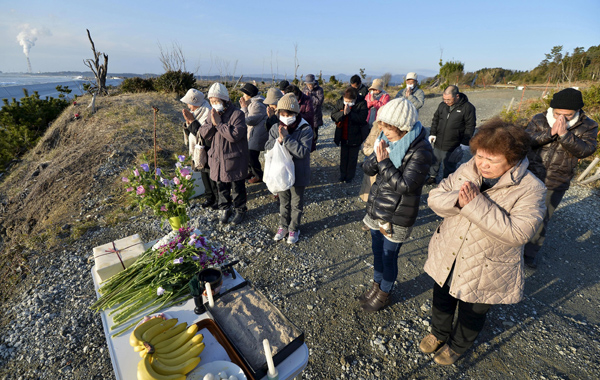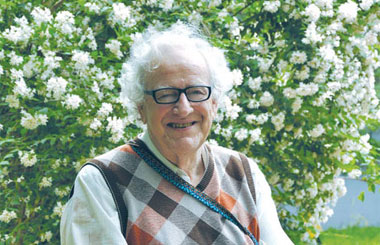Truths covered about Fukushima surface over five years
Updated: 2016-05-23 11:00
(Xinhua)
|
|||||||||
 |
|
People pray toward the sea to mourn victims of the March 11, 2011 earthquake and tsunami disaster in Minamisoma, Fukushima prefecture, Japan, March 11, 2016, to mark the five-year anniversary of the disaster. [Photo/Agencies] |
Facts about the Fukushima nuclear disaster triggered by a powerful earthquake kept emerging over the past five years after the mishap took place, revealing the real face of the disaster.
In front of the local government of Iidate Village in Japan's Fukushima Prefecture, there stands a sharp radiation measuring device. On its spotless dashboard jumps a red number: 0.38 microsieverts/hour.
The spot is about 40 kilometers from the Fukushima Daiichi nuclear power plant which was crippled by the monstrous quake-triggered tsunami in March 2011.
However, volunteer Yoichi Tao who majored in physics said the figure of radiation on their own device is 8 to 10 times of the official one.
According to Tao, the government dispatched the military to wipe out the nearby nuclear radiation on the ground in advance, so the official figure looks very low. "That's how the government did it," he said.
Toshihide Tsuda, professor of environmental epidemiology at Okayama University, found out that the rate of children suffering from thyroid cancer in Fukushima Prefecture was as much as 20 to 50 times higher than the national average as of 2014, three years after the Fukushima nuclear disaster.
His finding, however, did not arouse concern from the Japanese and local governments. On the contrary, it was rejected by the Fukushima prefectural government, attributing the phenomenon to a surge of "over diagnosis." The local government insisted the cancer incidents and nuclear radiation were not related.
The Japanese government admitted in August 2013 that at least 300 tons of highly-contaminated water flew freely into the Pacific Ocean everyday, and the problem might linger for ages. However, in September the same year, Japanese Prime Minister Shinzo Abe told the international community when Japan was bidding for the 2020 Olympic Games that the crisis was "totally under control."
It has also been revealed that TEPCO, or Tokyo Electric Power Company, had knowledge of multiple meltdowns at the plant's reactors following the tsunami, but intentionally refrained from informing the public of the fact until recently.
Underestimating the long-term impact of the accident could lead to a slack supervision on affected foods. It may also produce an unrealistic optimism in the Japanese government, thus the official handling of the aftermath would be careless, experts warned.
Related Stories
Fukushima five years on: Searching for loved ones 2016-03-11 10:46
Japan's nuclear refugees face bleak return 5 years after Fukushima 2016-03-03 09:51
Ex-TEPCO executives indicted over Fukushima nuclear disaster 2016-02-29 15:57
Japan brings 2nd nuke complex since Fukushima meltdowns back online 2016-01-29 17:30
Japan to bring first nuke plant online since Fukushima disaster 2015-08-11 10:06
Japan approves increase in Fukushima compensation to $57 bln 2015-07-28 19:00
Today's Top News
Wreckage of crashed EgyptAir plane found at sea
Still learning
EgyptAir denies finding wreckage of missing flight
China urges US to halt close surveillance
Debris found in sea in search for missing MS804
LinkedIn matches refugees with jobs
Top legislator foresees bright future for SAR
UN climate talks resume to write 'rule book'
Hot Topics
Lunar probe , China growth forecasts, Emission rules get tougher, China seen through 'colored lens', International board,
Editor's Picks

|

|

|

|

|

|







